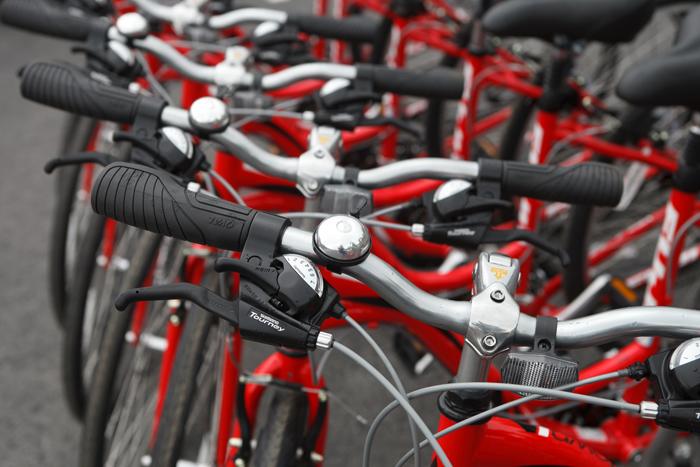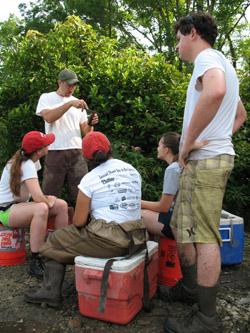Dickinson Is One Cool School

The Carlisle Circulator features a front-end rack that holds two bikes.

Assistant Professor of Biology Scott Boback measures a captured turtle as his students look on. Student researchers learned firsthand what environmental subtleties might affect all the organisms living in the pond. It’s an experience they can’t get in the classroom. Immersive research opportunities like this are possible with Student Faculty Research Project Grants from Dickinson’s Center for Sustainability Education.
By Christine Baksi
For the second time this summer, Dickinson has been nationally recognized as a top school for sustainability. Sierra magazine is the latest to laud Dickinson as a leader in sustainability education and green campus operations by placing it at No. 2 on its top 10 list of the "Coolest Schools" in the nation. Earlier this month, Dickinson earned a spot on The Princeton Review's 2014 Green Rating Honor Roll, making it the only Pennsylvania institution this year to earn both accolades.
Sierra's list salutes progressive U.S. colleges that incorporate curricula to help solve climate problems and are making significant efforts to operate sustainably. Powering Dickinson to Sierra's top 10 are the extensive student-faculty research opportunities found at the forefront of the college's sustainability curriculum. The Center for Sustainability Education provides research-collaboration support through generous grants for professional- and curriculum-development, student-faculty research, assistantships and student travel for research-related presentations.
Dickinson earned some of Sierra's highest marks for instruction & research opportunities and co-curricular offerings such as the Biodiesel Fuel program and the student Eco-Reps program, a peer-to-peer approach to encouraging sustainable campus living.
What makes a school cool?
Sierra examined academic institutions that are making a difference for the planet and creating tangible change in all categories of greenness, from campus operations to academics. According to Sierra, Dickinson is a cool school for purchasing enough wind power to offset all electrical needs, converting cooking grease into biodiesel fuel and serving student-grown produce in the cafeteria.
Dickinson has undertaken such initiatives as the student-introduced Idea Fund, which has supported ventures like The Handlebar, a teaching bike-repair shop and The Peddler, a bike-powered cart selling free-trade and organic coffee; the Center for Sustainable Living; an organic farm; water monitoring, recycling and composting programs; and ensuring LEED Gold certification for four buildings.
In 2012-13, sustainability-related and -focused courses represented 14 percent of the curriculum, with more than 60 percent of students taking at least one course and 30 percent taking two or more; nearly 80 percent of the class of 2013 took one or more sustainability courses in their last two years of study.
Highest honors
Dickinson's innovative sustainability curriculum and its leadership in sustainable campus operations consistently earn national recognition. Dickinson also has received the STARS Gold rating from the Association for the Advancement of Sustainability in Higher Education, garnered top marks on the Green Report Card of the Sustainable Endowments Institute and earned Second Nature's inaugural award for Institutional Excellence in Climate Leadership.
In 2012, Dickinson began presenting its own coveted award for environmental leadership. The Sam Rose '58 and Julie Walters Prize at Dickinson College for Global Environmental Activism was established by the couple to focus attention on the need to reduce the impact of human lives on the planet. Activist and scholar Bill McKibben received the inaugural prize, and former EPA administrator Lisa Jackson is the 2013 recipient.
Sierra is the official publication of the Sierra Club, America's largest and most influential grassroots environmental organization, with more than 2.1 million members and supporters nationwide. Read Sierra's coverage of the nation's greenest schools.
Published November 8, 2013